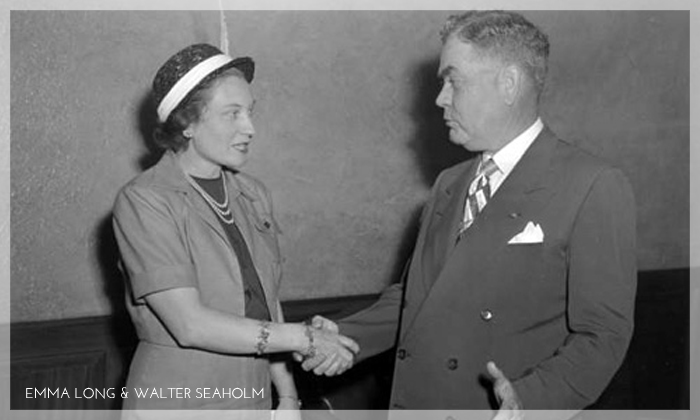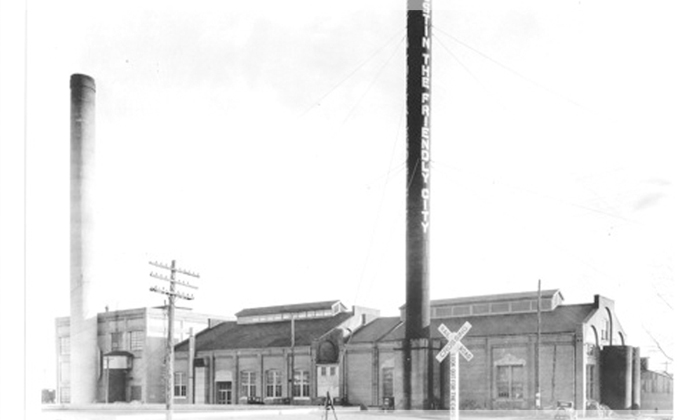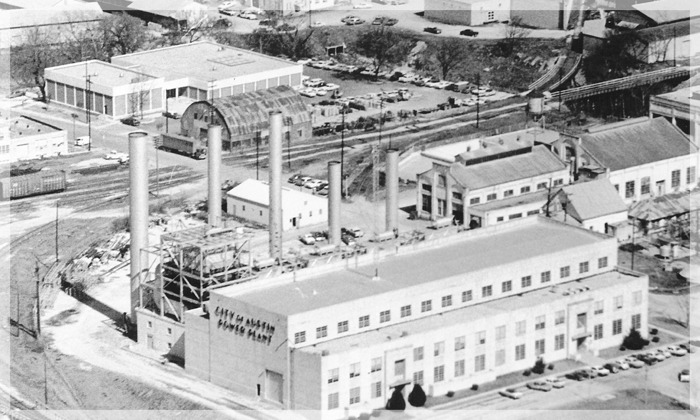

-
FOR INFORMATION : EMAIL SEAHOLM POWER, LLC



PRESERVING Seaholm's PoweR
How a sole structure survived all odds, and became an urban oasis for future generations
By: Mary Alice Kaspar
Walk inside the hollow cement structure that was once the hub of Austin’s energy creation, and you’ll hear every footstep echo through the vast chamber. Listen more closely, and you’ll learn the stories of people and purpose of a bygone era. You’ll see a cement walls and industrial remnants coupled with thick window panes and historic signage – all original from a time when structures were designed to endure for generations. And you may even smell the faint scent of cherry tobacco from a friendly ghost named Herman, according to a former plant caretaker.
It’s easy to understand why the community rallied to save this iconic structure. Yet, it’s nearly impossible to fully fathom the undertaking of giving new life to an outdated, environmental train wreck.
Looming 50 feet high and 270 feet long, the Seaholm Power Plant has held its own in history books since its inception in 1951. It was constructed of pure, site-cast cement when structures of a similar time era were mixing elements. It endured past the turn of the century – at a time when it’s contemporaries were long put to pasture, finding their shells being torn down to make way for scraped-earth new developments.
It’s that massive concrete, art-deco styled structure – that’s tall, but not too tall – that’s caught Austinites’ eyes along the shores of Lady Bird Lake for more than 50 years. Standing three stories above ground, the height created what many consider an ideal “stair step” effect from the hike and bike trails to other, taller towers comprising downtown’s skyline. The plant itself been described as everything from ugly to ethereal, eyesore to icon. The adjectives, the people and its purpose have come and gone, but its undeniable energy managed to embody enough power and strength of onlookers to ensure its perpetual survival.
There’s a lot of history before and after the Austin City Council, and nearly 25 years for rebirth to become reality. But Seaholm had perhaps the most treasured thing one could hope for in its aging state: friends.
You Got to Have Friends
When the designation of “historical” is placed on a structure, it’s generally well-vetted, well-documented, and in Austin, sometimes contentiously debated. Such designations carry legal ramifications, requiring structures to remain true to their original edifice in perpetuity – meaning current and future owners can’t make changes that would materially alter the look and feel of the property. In Seaholm’s case, the lakefront site was sure to generate greater income if the power plant structure was razed, enabling a new, and likely much taller, structure to rise.
In the long run, it’s typically only the structures with a community of cheerleaders that make it all the way to official designation stage, ensuring their survival. One of Seaholm’s most vocal advocates was well-known Austin architect Sinclair Black.
“It is a magnificent building, it is an iconic symbol. It is one of the most interesting spaces I’ve ever been in, and I’m a 69-year-old architect that has traveled the world and seen a lot of spaces,” Black told Community Impact in 2009. “I’ve never seen a space more interesting than the inside of that building.”
Black co-founded an organization called Friends of Seaholm in early 1980s with a sole focus: saving Seaholm from demolition. While promoting the group’s efforts, the Austin Chronicle referred to them as “quixotic crusaders” – a clear implication of how improbable the pursuit of such an ideal was at the time.
But by 1997, the Austin City Council resolution that had passed six years earlier materialized into a request for proposals and ideas on how the structure could be reused. The City appointed the Seaholm Reuse Planning Committee, which published results in 1998 stating their belief that the building was ideally suited for reuse as a major civic venue.
Momentum and public support continued to build. Seaholm Power Plant was officially recorded as a Texas Historic Landmark in 2007, and a listed on the National Register of Historic Places in 2013. And in between that time, the City of Austin made its official request for a redevelopment partner – one with a special resume and vision for uniting the site’s powerful past with Austin’s vibrant future.
Coming to Power
When the Seaholm Power Plant was commissioned in 1948, Austin was a town of not quite 132,000 people. World War II and post-war shortages meant the city had not upgraded its infrastructure since 1940, when its population had just 87,930 people. Not only did the larger population mean greater demand for electricity, but so too did lifestyle changes. There was an appetite for new, postwar devices such as air conditioning, televisions, washing machines and dish washers. In addition to meeting Austin’s increased demand for electricity, the new Seaholm complex also served as the home of the entire municipal electric department.
The nationally-recognized engineering firm Burns & McDonnell designed the complex, which was constructed in two phases in 1951 and 1955. It includes three structures that contributed to power generation: the Turbine Generator Building (TGB) and its associated smokestacks and boilers, the Water Intake Structure, and the Oil Heating Building – as well as a guard booth and storage building. The main plant featured gas/oil generation units, a towering turbine room that measures 110 by 235 feet and a 65-foot-high ceiling. Clerestory windows flank the upper aisles and let the sunlight stream through all three floors of the structure, joined with an underground basement of sorts that features pipes connecting to the Water Intake Structure at the bank of the lake.
The meticulous design is hailed as an outstanding example of the Art Moderne architectural style and shares many elements of the engineering firm’s other designs for municipal waterworks and powerhouses of the 1930s through the 1950s. Austin differs in that it is constructed entirely of site-cast concrete while their other plant examples were of brick cladding over concrete or steel structural systems.
The second phase wrapped up construction in 1958. At the time, it was referred to as Power Plant No. 2, and it housed five boilers, known as Boiler Nos. 5 through 9. Boilers Nos. 1 through 4 were located just east of the site, and constituted Power Plant No. 1.
Seaholm served as Austin’s sole source of power from 1950 to 1959, until demand outpaced even full 100 megawatts the plant could generate with all five boilers running. Other, newer, more efficient plants with the names of Holly and Decker were constructed. In the late 1980s, reliance on Seaholm waned. It stopped generating power in 1989, but remained active as a training facility. New operators learned their trade before being tasked to work at other sites. Boiler 8 was shut down at 5:18 pm on July 28, 1992, marking the official stopping point of power generation at the site. The final three generators were completely shut down in 1996.
What’s in a Name
On June 2, 1960, Power Plant No. 2 was posthumously named in honor of Walter E. Seaholm. A prominent figure in the administration of Austin’s municipal utilities from the 1920s until the mid-1950s, the “gruff-spoken” Walter Seaholm was Austin's fourth city manager and a former utility director.
He’s also is credited for saving Austin’s power not once, but twice over the course of his career.
The City of Austin has owned its generation and distribution system since the arrival of power in 1893. However, in 1927, a private entity, Texas Power and Light Company (TP&L), made a bid to purchase Austin’s municipal utility – claiming it could operate it more cheaply. It was Walter Seaholm, then working as a superintendent, who prevailed in making the case that TP&L was wrong. He demonstrated a more economical operation of the plant than engineers thought was possible, thus ensuring the utility remained municipal-owned. The dedication plaque on Seaholm’s East Entry acknowledges his role in the “preservation of this city’s ownership of its electrical system…”
The second time Walter Seaholm stepped up was during the great flood of the Colorado River in June of 1935. The flood was so severe, it knocked out the city’s power and drinking water. Walter Seaholm helped flip the switch back on by patching into TP&L’s system, and established an emergency drinking water pump. More than 10 years later, an Austin American-Statesman headline heralded: “Power Man Seaholm Never Blew a Fuse.”
Darkest Before the Dawn
After power generation ceased, the plant lay in a dormant state. Landscaping became overgrown as windows cracked and graffiti gathered. Prompted by citizens’ desire to save what became a beloved iconic structure and part of the Lady Bird Lake landscape, in 2004, the Austin City Council requested proposals for redevelopment partners.
In late April of 2005, the Seaholm Power, LLC team – consisting of key team members John Rosato, Daniel Roth, Kent Collins, Allen Cowden and Jeff Trigger – was selected to create and execute a plan that would make new use of the defunct power plant as well as the surrounding site – totally 7.8 acres in all. Later, David Stauch joined as project manager and partner.
With developers often at odds with the Austin populace – and the Austin City Council sitting squarely in the crossfire – Rosato and Roth had street credit for their work on the redevelopment of sites like Penn Field in South Austin. There, they transformed a World War I airfield site into an eclectic, modern mix of office and retail space. The community like its vibe and creative type tenants flocked to the unique environment.
Seaholm Power, LLC was careful to devise a redevelopment plan for their latest endeavor that paid homage to the site’s history while simultaneously adding enough new uses to generate enough income to justify salvaging the power plant. The breathtaking view of the turbine hall, for example, was to remain open and on display for the public – with the developers turning an uncharacteristically deaf ear to users clamoring for every possible square inch of office space to fill the expanse. The Great Recession delayed a project start, with project financing getting secured not once but twice along the way. The renovation of the power plant as well as the addition of a residential tower, mid-rise office/retail building and parking garage was in full swing by 2013.
But before anything new could rise, a great deal of environmental remediation was needed. Contaminants of lead paint, spilled mercury, asbestos, Cadmium and PCB (a cancer-causing coolant), warranted a nine-year, $13 million clean-up. In 2006, the site was finally deemed “Ready for Reuse” by the U.S. Environmental Protection Agency and the Texas Commission on Environmental Quality. Seaholm earned a special place in history once again – this time as the first facility in the nation to receive such a designation under the federal Toxic Substance Control Act.
It was also during this interim era that Seaholm was discovered as an “it” spot for intermittent use for special arts and music events. MTV made headlines when it was discovered the music network leased the power plant for just $500 a day for six days during SWSW – an intensely popular music and film festival that takes place annually in Austin over Spring Break. The fee, acknowledged as quite low, was attributed to the warehouse-like facility not having electricity or bathrooms. Other special events, such as the Blue Lapis aerial acrobatics and other private events helped Seaholm remain useful throughout its dormant days.
Trader Joe’s, a popular neighborhood-style grocer, became the first tenant to pre-lease space in 2012 – occupying a key location in the low-rise. Known as a gourmet foodie emporium, more than 4,400 people had signed an online petition to “Bring Trader Joe’s to Austin.” Street and media buzz about the announcement was swift and enthusiastic.
Seaholm’s residential tower, called the Seaholm Residences, also garnered headlines. A new condo project hadn’t joined downtown Austin’s skyline since 2008. Seaholm Power LLC originally envisioned the mixed-use project having a condo component, but switched the residential structure to apartments during the downturn – attempting to acquiesce to market demand. However, shortly after breaking ground, the team decided market winds had changed once again, and in September of 2013, announced Seaholm Residences would be the first new condo project to open in downtown six years. Priced from about $300,000 to $1 million-plus, nearly all units were reserved in about a week's time - a record for a downtown condo project, according to local experts.
Healthcare information technology giant athenahealth struck a deal to lease all of the office space in the Seaholm Power Plant (112,000 square feet) in January of 2014, on the heels of the Austin City Council and State of Texas approving incentive agreements. athenahealth agreed to invest $13 million in a research and development center, creating 607 jobs with an average annual wage of $130,000 over the next 10 years.
Other tenants continued to sign on board, including Boiler 9 Bar + Grill, a planned four-story restaurant nestled in the spot where the ninth boiler once resided. With athena taking occupancy February 2, 2015, the rebirth of the Seaholm site had begun.
Sources: “Silver in the Mine,” the city of Austin's long-term comprehensive energy plan; information contained in the National Register of Historic Places filling; FriendsOfSeaholm.com; a myriad of interviews with members of the Seaholm Power LLC redevelopment team, as well as Harold Reynolds and Oscar Backus with Austin Energy. Additional information was found in the Austin American-Statesman, Austin Business Journal, Austin Chronicle and Community Impact archives.